Oslo’s architectural prowess puts it on the cultural map
Oslo has placed cultural and public institutions at the centre of its urban renewal aspirations, with spectacular results.
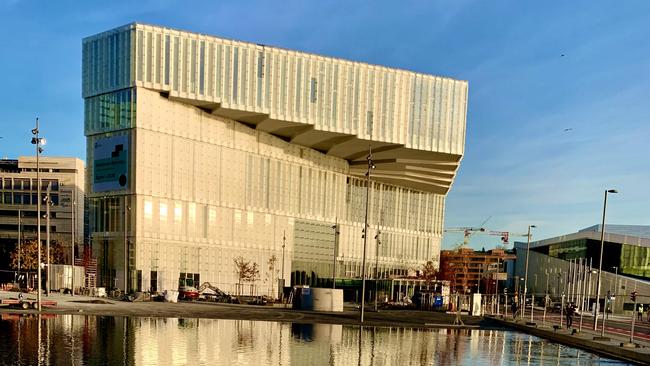
Like other post-industrial cities Oslo has been remaking dilapidated urban areas into shiny new live, work and play precincts. What sets Oslo apart is the dominant role played by cultural and public institutions in these urban renewal aspirations. As one of the world’s wealthiest nations, thanks largely to oil and gas exports and a fully functioning sovereign wealth fund, Norway can afford to spend big on culture.
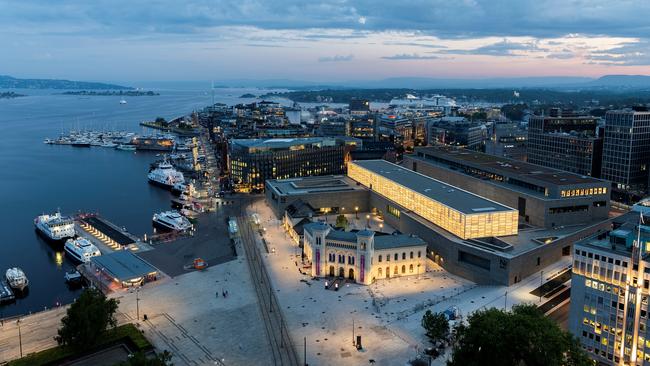
A cacophony of drums and horns echoes through the streets of Norway’s handsome capital as marching bands, one after another, descend on the waterfront. It’s a sparkling Nordic summer day and the mood is festive. Oslo, for an afternoon, could well be Rio.
On a stretch of manicured lawn at the south-eastern edge of the harbour, between the Renzo Piano-designed Astrup Fearnley Museum of Modern Art and the glinting Oslo fjord, milk-white Norwegians strip down to shorts and bikinis and mingle after a tough winter. Some brave the chill waters of the fjord. Others laze around the Sculpture Park, also designed by Piano. It’s 25C: a Norwegian heatwave.
Discover the world’s best fashion, design, food and travel in the December issue of WISH magazine.
The timber-clad Astrup Fearnley, a private museum housing a rather conventional international art collection coupled, this summer, with a striking temporary exhibition dedicated to Norwegian textile artist lies Snnove Anker Aurdal, is at the tip of Tjuvholmen – or Thief Island. The district earned its name in the 1800s not because pickpockets were prevalent but because it was on this sliver of land that felons were executed. Today it’s a chic waterfront district – some 1200 handsome apartments rise above street-level cafes and restaurants serving everything from Nordic seafood to robata grill dishes – and a key pocket of Oslo’s Fjord City urban renewal project.
Post-industrial cities the world over – Glasgow, London, Hamburg, Sydney, Melbourne – are remaking their disused docklands into shiny new live, work and play precincts. What sets Oslo apart is the dominant role played by cultural and public institutions in these urban renewal aspirations. As one of the world’s wealthiest nations, thanks largely to oil and gas exports and a fully functioning sovereign wealth fund, Norway can afford to spend big on culture.
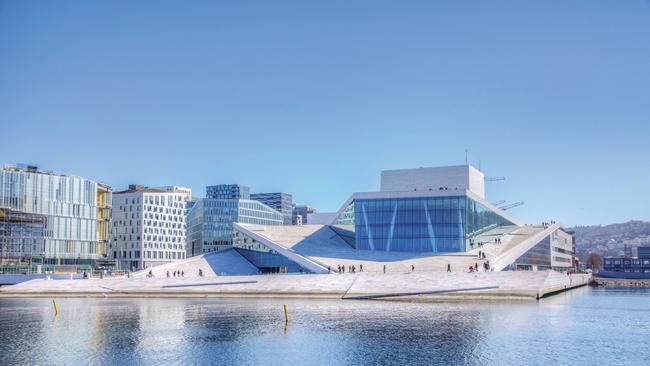
At Fjord City, commercial offices, apartments and retail are part of the mix. But the buildings dedicated to culture include, in addition to the $140 million Astrup Fearnley with its striking swooping roof, the much-anticipated $1 billion National Museum on the Tjuvholmen end of the western waterfront. Further east, wearing a price tag of $500 million, towers a new 13-storey museum dedicated entirely to the work of Edward Munch – Norway’s, if not Scandinavia’s, most famous artist. MUNCH – the museum’s upper-case logo is as assertive as the Juan Herreros designed building’s silhouette against the mid-rise Oslo skyline – opened in October last year and is proving popular with visitors.
The top floors of this 60m-high art tower are sharply angled, much like Munch himself. A rooftop bar and restaurant offer views west to the city and the 13th-century Akershus castle, and east to the forested hillside where the artist and two friends were walking the night he looked towards the sunset and felt, in his words, as if his soul had been “lacerated. The air turned to blood, with glaring threads of fire…” The emotion took the form of a motif: The Scream.

A short walk west along the foreshore, past Tracey Emin’s monumental bronze titled The Mother – a gift from the British artist to Munch, whose mother died when he was young – is the $760 million opera and ballet house designed by local practice Snøhetta in the shape of a squat iceberg. The new $530 million Deichman library “of the future”, designed by another local architectural hero, Lund Hagem, is just next door across Operagata.
The capstone and culmination of this array of cultural institutions is the National Museum of Art, Architecture and Design, designed by Naples-based German architect Klaus Schuwerk in collaboration with Berlin practice Kleihues+Kleihues, which opened during my visit. This 54,600sq m mega-museum – the largest in the Nordic region – is built on the site of the former westbound train station. Its sombre, sprawling edifice wraps around the restored Station Master’s House and 19th-century station façade, now the Nobel Peace Prize Museum. A piazza is formed from the cobbled courtyard between these heritage buildings and the museum.
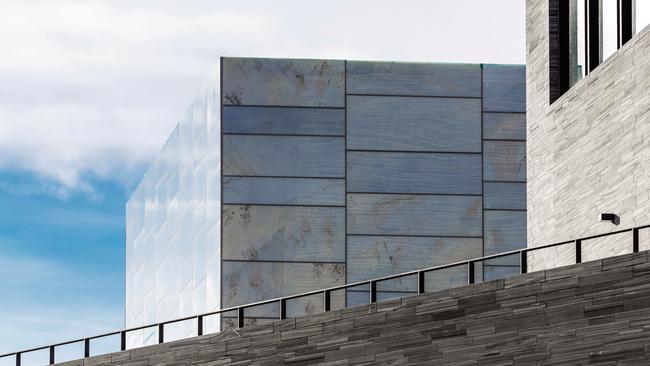
Clad in horizontally cut Norwegian slate, the building is big, boxy, and somewhat introverted. A rooftop Light Hall of wafer-thin translucent marble, sandwiched between glass panels and backlit by LED lights, adds a warm glow at night and a soft suffused interior light during daylight hours. No expense has been spared. The floors of the exhibition areas are of oak, those of the public areas German shell limestone. The fittings are brass and the vitrines for the displays are Italian.
Scale is in the museum’s DNA. It’s an amalgamation of five cultural institutions. The national museum, whose origins lie in the mid-19th century, has in essence gobbled up Oslo’s galleries of decorative arts, industrial design, architecture,and contemporary art. The end result is a repository of about 450,000 sculptures, drawings, textiles, ceramics, costumes and, of course paintings – the highlight of which is a room of Munch’s greatest hits.
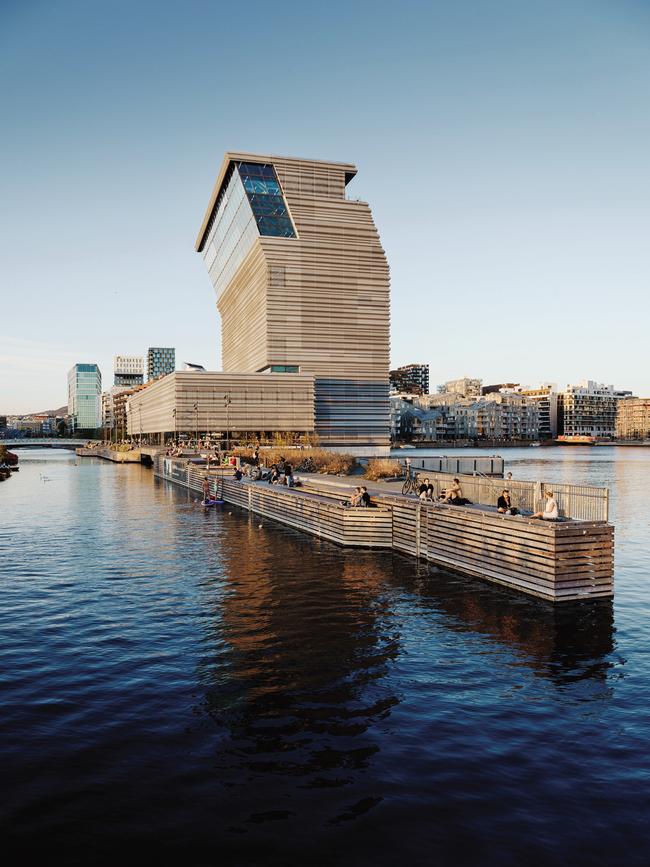
Director Karin Hindsbo describes it as “a modern museum with classic qualities built with beautiful and solid materials meant to last for several centuries”. Though only 6000 of its treasures can be shown at a time, this is still more than the five smaller dispersed museums could bring to the public gaze. Hindsbo also flags a rolling program of temporary exhibitions “in new formats”, as well as lectures and debates.
“In our time museums are rarely built from scratch,” she says. “This is a historic investment in art and culture. Our mission is to ensure that visitors in 100 years can come close-up to the brushstrokes in [Norwegian artist] Harriet Backer’s Blue Interior; that they can experience the vibrant colours in the nearly 1000-years-old Baldishol Tapestry; that they can understand more about the past through the art that was created in the 2020s.”
Blue Interior is indeed a glorious – and outside Norway, little-known – work of contemplative domesticity, deeply influenced by French Impressionism. The Baldishol Tapestry, discovered in Norway in the late 19th century, seems to have originated in 12th-century Normandy, England, Germany, Ireland or Catalunya – nobody knows for sure.

Contemporary art, Abstract Expressionism, Minimalism and more politically inflected art is amply represented by the Fredriksen Family Collection, described by the museum as a “living collection ... to which new works are added all the time”. This collaboration between the museum and Cecile and Kathrine Fredriksen – daughters of Norway’s richest man, John Fredriksen – is not however without controversy. Critics have questioned the propriety of a private gallery operating within a public institution, even if it’s curated by the museum.
The most potent work of protest – a display of 400 polished reindeer skulls, each one bearing a fatal bullet hole – greets the visitor in the foyer. Titled O Sapmi Supreme (Pile of Bones), the installation is by Sami artist Maret Anne Sara, whose work is showing at this year’s Venice Biennale. The work is a cry from the heart and a call to action following a reindeer cull enforced by the government. ”Our grazing land is expropriated for industrial development,” remarks the artist. “Then the Reindeer Husbandry Act gets amended to justify compulsory slaughter ... We’re being brought to our knees, both as individuals and as a society.”
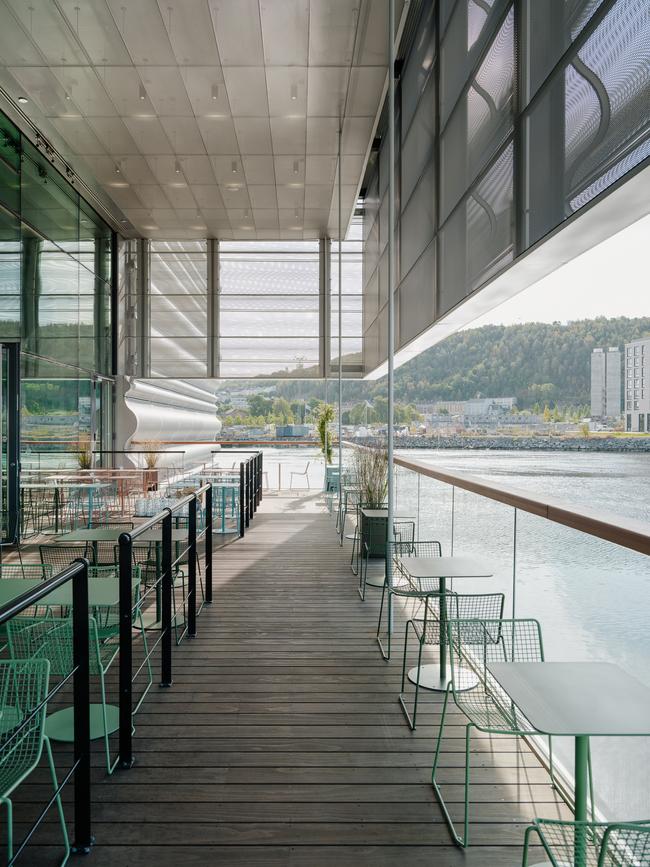
The main drawcard will, of course, be the room dedicated to the ubiquitous Edward Munch: a distillation of his vast artistic legacy into 18 stunning works, including the erotically charged Madonna and a string of the artist’s more characteristically maudlin paintings such as The Girls on the Bridge, The Dance of Life, and Ashes. The museum claims to have the original version of Munch’s The Scream, which it proudly displays here. The 13-storey MUNCH tower, in contrast, has eight different versions in three different mediums – tempera and oil on cardboard, crayon on cardboard, and lithograph – though it shows only one at a time.
The national museum’s permanent collection, spanning the contemporary and classical worlds, fine arts and crafts, is encyclopaedic and fine grained, wide angled and close cropped; global and provincial. An entire room is dedicated to the work of Norway’s most famous architect, 1997 Pritzker-prize winner Sverre Fehn, even though his fame doesn’t extend widely beyond.
A survey of European Impressionism, Post-Impressionism, Expressionism, and Abstract Expressionism is also on offer. There is a Van Gogh self-portrait, a Cezanne still life, and works by Gauguin, Courbet and Delacroix. Valuable in themselves, they also point to the evolution of Norwegian art. Munch, for example, was influenced by Impressionism in his youth and in his maturity deeply influenced the Expressionist movement, of which he is often considered the father.
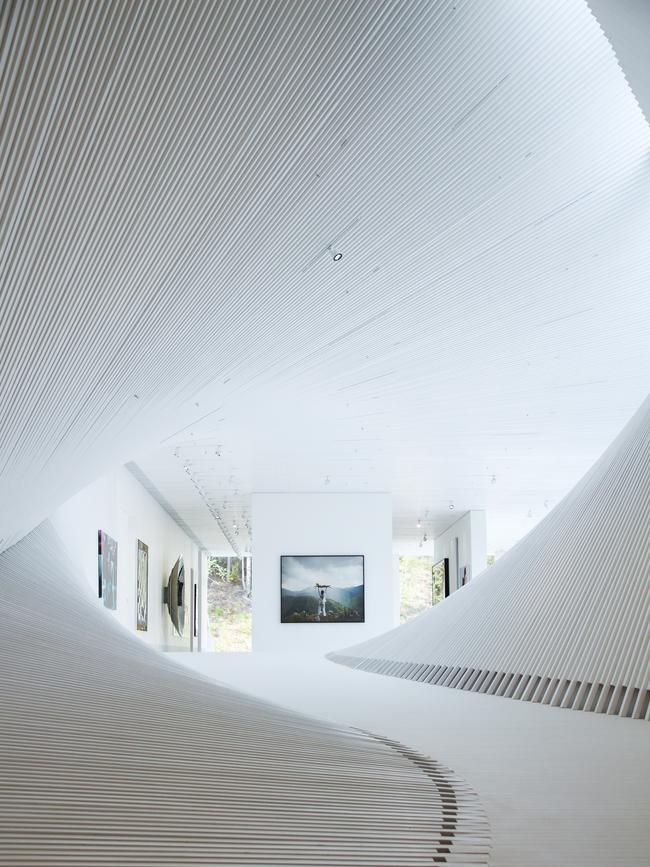
Of the museum’s 86 galleries, those most likely to surprise visitors outside Scandinavia – and the museum is in part a machine for attracting international visitors – are dedicated to Norway’s own tradition of landscape painting. The national gallery has been collecting landscapes – Norwegian and European – since the mid-19th century. The subjects of these works, Romantic in tone, include majestic mountains (Johan Christian Dahl’s View from Stalheim), noble peasants (Hans Gude and Adolph Tideman’s ’s A Bridal Procession in Hardanvgerfjord), and the fjord-fringed coast (Adelsteen Normann’s A Fishing Village in the North of Norway).
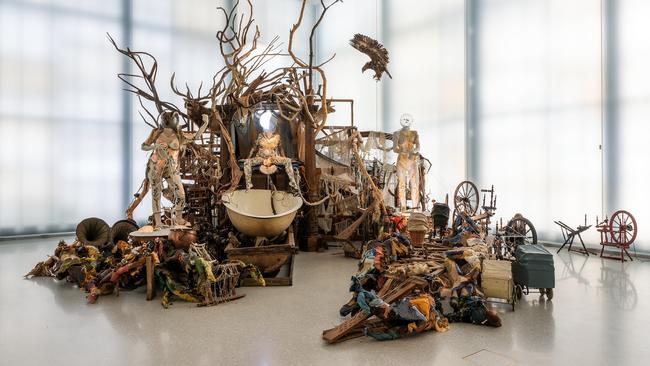
An entire room is dedicated to Dahl, but if there is one painting in this genre likely to speak to the adventurous spirit in which so many come to Norway – and so many Norwegians pride themselves – it’s Harald Sohlberg’s sublime Winter Night in Rondane. The painting, a favourite among Norwegians, has its origins in a train trip the 30-year old Sohlberg took in 1899 from Oslo (or Kristiana, as it was called then) north into the Rondane mountains. One frozen night the artist had an intense, almost mystical, experience of the frozen landscape under a clear sky. “The mountains in winter leave one speechless, moved,” he wrote. “Something like being beneath the lofty vaults of a cathedral. Only a thousand times stronger.” The painting took 15 years to complete. The result is a glowing blue, almost opaline, snow-clad landscape. It is shown alongside a roughly contemporaneous bronze, titled The Youth, by the great Norwegian sculptor Ingebrikt Vik. The muscled figure stands, legs together, weight on one foot, arms behind his back, looking to the ground in a pensive pose.
Norway’s National Museum of Art, Architecture and Design was conceived in controversy. Before it had even opened its doors, the composite body – sum of the old national museum and four others – had gone through five directors. Controversy continued to dog it in the lead-up to the June 11 public opening.
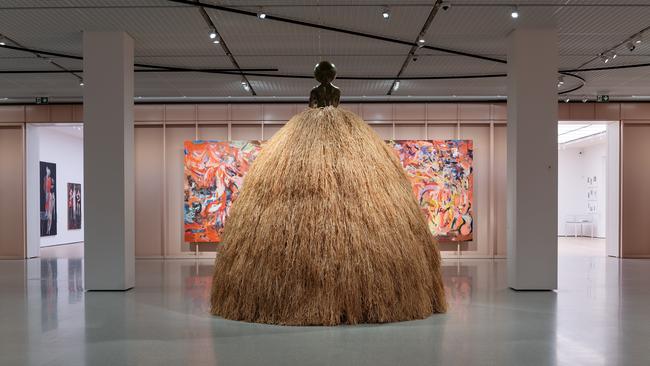
Architect Klaus Schuwerk had been critical of the museum’s signage, digital monitors and some of the interior design choices, as well as the inaugural contemporary Norwegian art show planned for the Light Hall with its majestic 7m-high ceiling. During a press preview a week out from the opening, he recycled these criticisms, and more, alluding to “bloody battles” behind doors with museum authorities.
Hindsbo, appointed in 2017 to steer the ship home, alludes to a “long and demanding” process, and addresses the conflict with Schuwerk diplomatically by insisting on a distinction between the “realm of the architect and the realm of the user. It might be clear, or not so clear, where to draw the line”. She credits Schuwerk for an “amazing building, an amazing museum”.
It is not, on the other hand, a showy building. It attempts no Gehry-ish gymnastics. The interior is organised around long corridors that terminate in sculptures or interior-courtyards. Schuwerk regards it as a building of classical proportions and clarity of vision, and on this essential point he and the museum’s director agree.
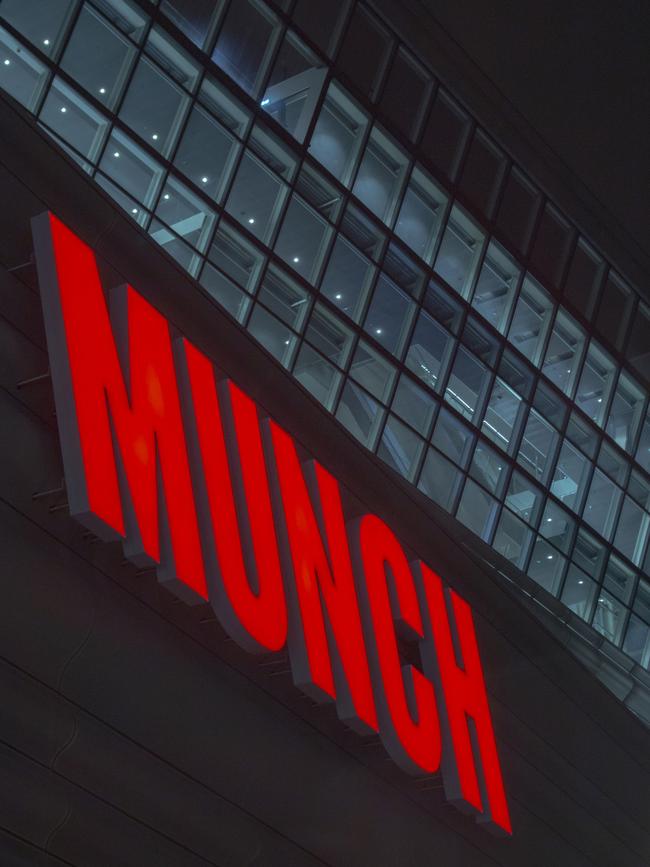
Hindsbo hopes that a collection of this size – together with the temporary exhibitions – will sensitise visitors to “the power of images, the visual cultures of earlier ages, and how our culture is shaped visually”. She stresses the role of museums as sanctuaries – “places for relaxation, silence and reflection, a place with a different pace. A museum can nourish our imagination and inspire us to be creative. The museum is the most important meeting place in society.”
The new national museum is the culmination of Oslo’s ambitious program of urban renewal: a magnet, along with the Astrup Fearnley, MUNCH, the harbourfront opera house and Deichman Library, for Norwegian and international visitors. “Norway is so much more than fjords and mountains, and I think that will actually be a surprise for people when they visit,” says Hindsbo.
This sentiment speaks directly to the city’s ambition to cement its place on the global cultural map and compete with Stockholm, Helsinki, and Copenhagen for tourists, international attention and cultural prestige. And yet if Norway hadn’t nurtured an artistic movement dedicated to painters inspired by those “fjords and mountains”, the national museum wouldn’t be half as interesting, or distinctive, as it is.
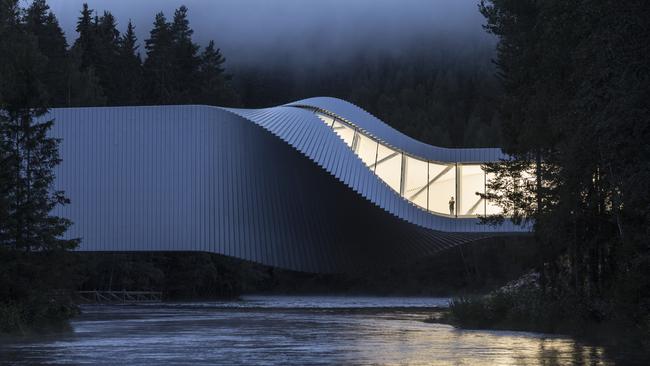

To join the conversation, please log in. Don't have an account? Register
Join the conversation, you are commenting as Logout